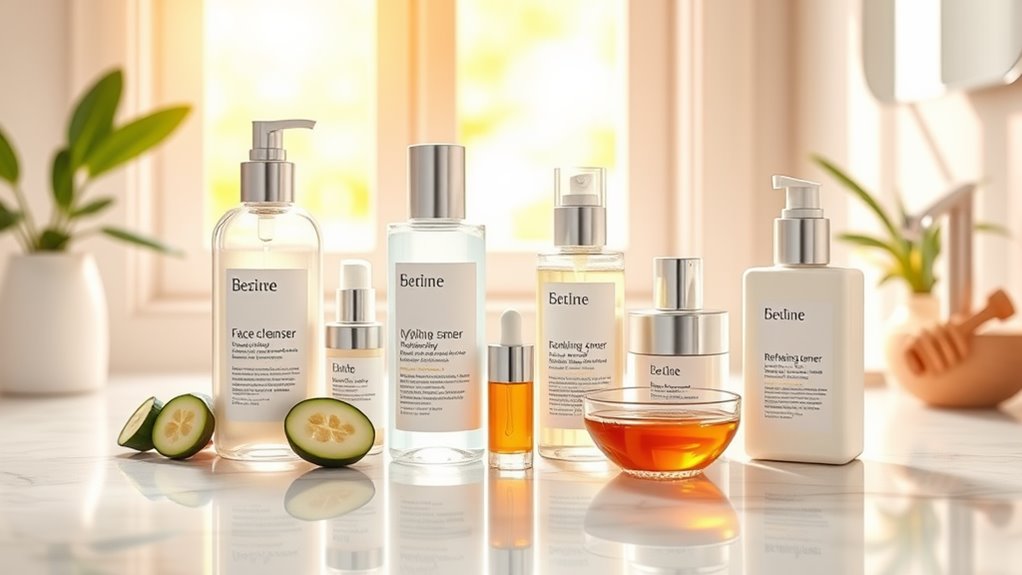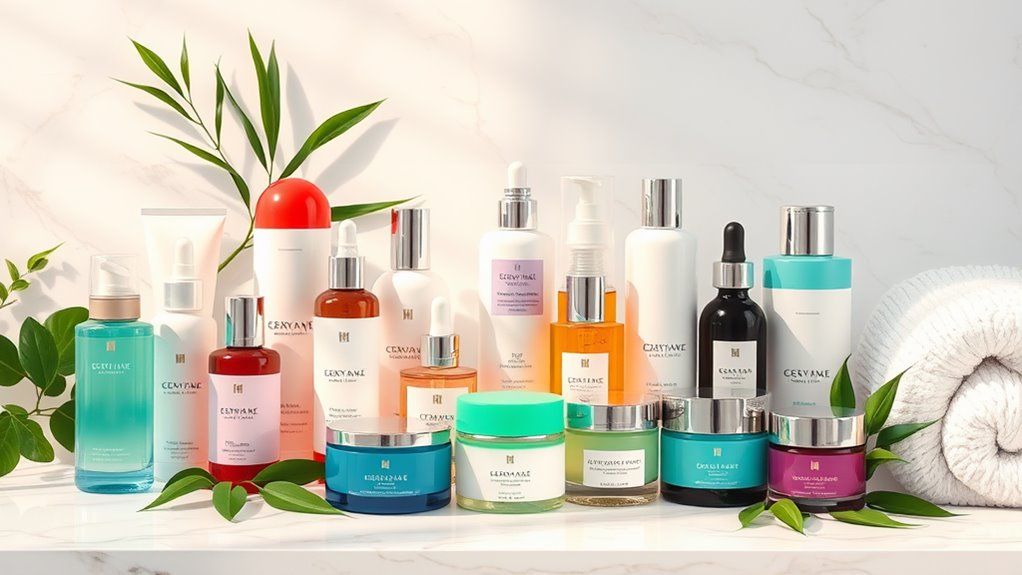This Simple Routine Works for Every Skin Type
No matter your skin type, a simple routine can transform your skincare game. By understanding your unique needs and following a reliable four-step process, you can achieve healthier skin with ease. Each step—cleansing, exfoliating, moisturizing, and protecting—plays a vital role. But how do you tailor these steps to work best for you? Let’s break down the essentials and find the perfect approach for your skin.
Key Takeaways
- A reliable four-step routine includes cleansing, exfoliating, moisturizing, and protecting, catering to all skin types effectively.
- Use gentle, skin-type specific cleansers to remove impurities without irritation or excess dryness.
- Exfoliate 1-3 times a week, choosing physical or chemical methods based on skin tolerance and type.
- Moisturize with appropriate formulas; lightweight for oily skin and rich creams for dry skin, ensuring hydration.
- Always apply broad-spectrum sunscreen with at least SPF 30 to protect against UV damage, regardless of skin type.
Understanding Your Skin Type
How well do you really know your skin? Understanding your skin type is essential for crafting effective skincare routines. Your skin can be oily, dry, combination, or sensitive, and each type requires tailored products and approaches.
For instance, if you struggle with excess oil, you’ll need lightweight, non-comedogenic formulations to prevent breakouts. Conversely, dry skin benefits from rich, hydrating ingredients that lock in moisture.
Combination skin demands a delicate balance, while sensitive skin requires gentle, fragrance-free options. By identifying your skin type, you can select the right cleansers, moisturizers, and treatments, ensuring your skincare routines deliver maximum results. Additionally, chronic stress can negatively impact your skin’s health, making it essential to manage stress as part of your skincare regimen.
Mastering this knowledge not only enhances your skin’s health but also elevates your overall confidence in your self-care practices.
The Essential Four-Step Routine
To achieve healthy skin, you need a reliable four-step routine. Start by cleansing to remove impurities, then hydrate and protect your skin for a radiant glow. Incorporating natural ingredients such as vitamin C and licorice extract can significantly enhance your results. Let’s break down each step to help you get the best results.
Cleanse for Clarity
While maintaining a clear and radiant complexion may feel challenging, following a simple four-step cleansing routine can make all the difference.
Start by selecting a gentle cleanser that suits your skin type. Use it twice daily to remove dirt, oil, and impurities, ensuring your pores stay clear.
Next, incorporate an exfoliating product two to three times a week. This step helps eliminate dead skin cells, promoting cell turnover and brightness.
After exfoliating, consider a toner to balance your skin’s pH and tighten pores.
Finally, always finish with a nourishing serum tailored to your skin’s needs, laying the groundwork for enhanced clarity.
Stick to this routine consistently, and you’ll reveal the secret to a luminous, healthy complexion.
Hydrate and Protect
As you aim for healthy skin, incorporating hydration and protection into your routine is essential.
Start by applying a lightweight moisturizer suited to your skin type; this locks in moisture and creates a barrier against environmental stressors.
Follow this with a broad-spectrum sunscreen during the day, ensuring your skin is shielded from harmful UV rays. Even if it’s cloudy, don’t skip this step—consistent protection is key to preventing premature aging and skin damage.
For nighttime, consider a nourishing serum rich in antioxidants, enhancing hydration and repairing your skin while you sleep.
Step 1: Cleansing for All Skin Types
Cleansing your skin is the essential first step in any skincare routine, ensuring that dirt, oil, and impurities are removed. No matter your skin type—oily, dry, or combination—proper cleansing sets the foundation for your regimen. Use a gentle cleanser that respects your skin’s natural barrier. Incorporating effective ingredients like scientifically-proven methods can also enhance the benefits of your cleansing routine.
| Skin Type | Recommended Cleanser | Frequency |
|---|---|---|
| Oily | Gel or foam cleanser | Twice daily |
| Dry | Cream or lotion cleanser | Once daily |
| Combination | Balancing cleanser | Twice daily |
| Sensitive | Fragrance-free cleanser | Once daily |
Step 2: Exfoliation Techniques
Now that your skin is clean, it’s time to focus on exfoliation.
You’ll want to understand the difference between physical and chemical exfoliation, as well as how often you should be doing it.
Choosing the right products is essential to keep your skin healthy and glowing.
Physical vs. Chemical Exfoliation
Exfoliation is an essential step in your skincare routine, whether you prefer the physical scrubs that slough away dead skin or the chemical formulas that dissolve impurities.
Understanding the differences between these methods can help you choose what’s best for your skin.
-
Physical Exfoliation****: Uses granules or tools to manually scrub away dead skin.
-
Chemical Exfoliation: Employs acids or enzymes to break down bonds between skin cells.
-
Immediate Results: Physical exfoliants often provide instant smoothness.
-
Gentle Approach: Chemical exfoliants can offer deeper results without abrasion.
-
Skin Type Consideration: Choose based on sensitivity; some may react better to one method over the other.
Mastering these techniques will elevate your skincare routine, revealing a brighter, healthier complexion.
Frequency of Exfoliation
Finding the right frequency for exfoliation is key to maintaining healthy skin. Generally, you should exfoliate 1-3 times a week, depending on your skin type and tolerance. Over-exfoliating can lead to irritation, while under-exfoliating may result in dullness.
Here’s a simple guide to help you determine how often to exfoliate:
| Skin Type | Recommended Frequency |
|---|---|
| Oily | 2-3 times a week |
| Combination | 1-2 times a week |
| Dry/Sensitive | Once a week |
Adjust your routine based on how your skin reacts. Listen to your skin’s needs, and don’t hesitate to modify your frequency as seasons change or your skin’s condition evolves. Mastering this step will elevate your skincare game considerably.
Choosing the Right Products
How can you choose the right products for exfoliation? Selecting the perfect exfoliant is essential for enhancing your skin’s health. Here are some key factors to take into account:
-
Skin Type: Identify whether your skin is oily, dry, or sensitive to choose compatible products.
-
Exfoliation Type: Decide between physical (scrubs) or chemical (ACIDs) exfoliants based on your skin’s needs.
-
Ingredients: Look for beneficial ingredients like alpha hydroxy acids (AHAs) or beta hydroxy acids (BHAs) for targeted results.
-
Frequency: Choose products that align with your exfoliation routine to prevent over-exfoliating.
-
Patch Test: Always perform a patch test to confirm your skin tolerates the product.
Step 3: Moisturizing for Balance
Moisturizing is a crucial step in your skincare routine, as it helps maintain your skin’s hydration and balance. Regardless of your skin type, a good moisturizer can work wonders.
For oily skin, opt for a lightweight, oil-free formula that hydrates without clogging pores. If you have dry skin, choose a richer cream packed with nourishing ingredients like hyaluronic acid or ceramides.
Combination skin benefits from a gel-cream hybrid to address both oily and dry areas effectively. Remember to apply your moisturizer while your skin is still damp for maximum absorption. Additionally, using a moisturizer that contains anti-aging ingredients can further assist in preventing premature signs of aging.
Don’t forget to massage it in gently; this not only enhances absorption but also promotes circulation, giving your skin that coveted healthy glow. Mastering this step guarantees your skin stays balanced and radiant.
Step 4: Sun Protection Essentials
While you may have mastered cleansing and moisturizing, protecting your skin from the sun is just as essential for maintaining its health.
UV rays can cause premature aging, pigmentation, and even skin cancer. To guarantee your skin stays radiant and youthful, follow these sun protection essentials:
- Use a broad-spectrum sunscreen with at least SPF 30.
- Reapply sunscreen every two hours, or immediately after swimming or sweating.
- Seek shade during peak sun hours (10 a.m. to 4 p.m.).
- Wear protective clothing, like wide-brimmed hats and long sleeves.
- Incorporate antioxidant-rich serums to combat free radical damage.
Additionally, remember that proper eye area care is crucial, as the delicate skin around your eyes can be particularly susceptible to sun damage.
Frequently Asked Questions
How Often Should I Change My Skincare Products?
You should change your skincare products when you notice irritation, lack of results, or seasonal shifts. Regularly assess your skin’s needs and don’t hesitate to adjust your routine for ideal health and performance.
Can Diet Affect My Skin’s Health?
Absolutely, your diet greatly impacts your skin’s health. Eating nutrient-rich foods helps maintain hydration and elasticity, while processed foods can lead to breakouts. Focus on whole foods to achieve that glowing, healthy complexion you desire.
What Ingredients Should I Avoid for Sensitive Skin?
You should avoid harsh fragrances, alcohol, and sulfates in your products. These ingredients can irritate sensitive skin, leading to redness and discomfort. Instead, opt for soothing, gentle formulations that promote healing and calmness.
How Do I Know if a Product Is Non-Comedogenic?
To determine if a product’s non-comedogenic, check labels for specific terms, look for dermatologist-tested endorsements, and research ingredients known to clog pores. Testing on a small area can also help you gauge compatibility with your skin.
Is It Necessary to Use a Toner?
Using a toner isn’t strictly necessary, but it can enhance your routine. It balances your skin’s pH, removes leftover impurities, and prepares your skin for better absorption of serums and moisturizers, maximizing their effectiveness.
Conclusion
You’ve learned how to tailor a simple skincare routine to fit your unique skin type. By cleansing, exfoliating, moisturizing, and protecting your skin consistently, you’ll achieve that healthy, radiant glow you desire. Remember, everyone’s skin is different, so choose products that cater to your specific needs. Incorporating natural ingredients like vitamin C can boost your results. Stick to this four-step process, and you’ll be on your way to ideal skin health in no time!





